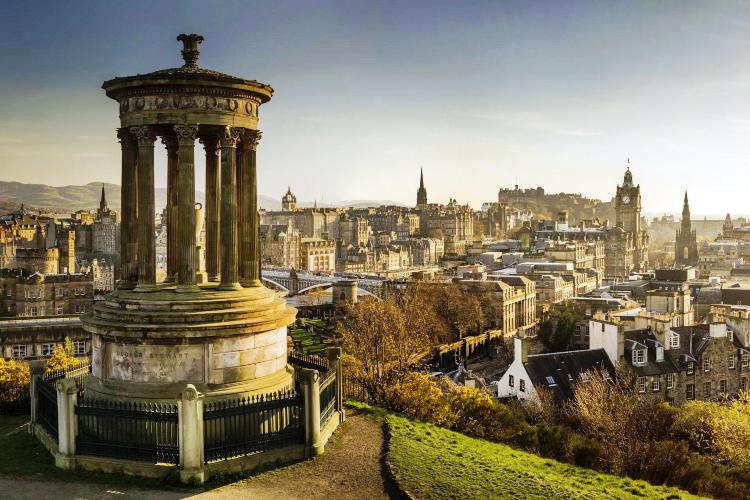
There’s not much to say about the urban sprawl heading into Edinburgh from the south. It looked like a lot of tough neighbourhoods where it would be easy to get into a scuffle in a pub if you spoke highly of a football team from England. But once we had made our way towards Old Town and got rid of our vehicle in a car park near Waverley Station, the city began to weave a spell over my wife Linda and me.
We paid a most handsome sum of money to stay at the Fraser Suites just a block from St. Giles Cathedral. It was a tad uphill from the car park (well, everything in Old Town seems to be quite up or down) and if rolling luggage over ancient cobble stones is exotic in your world, then this is the place for you. And I am indeed one of those travellers – excited by the notion that famous and notorious men and women from centuries past had helped to polish these stones with the soles of their shoes the same as me.
I had a small agenda of things to seek out in Edinburgh: pubs with dogs of course, literary connections, exploration of as many dark nooks and crannies as possible, and conversations with locals about whatever was forefront on their minds.
Those conversations, as it turned out, were harder to come by than I thought. It seemed that everyone we met on the street was from somewhere else. The street in question was High Street, and the section we traversed most was the famous “Royal Mile.” I would later learn that thirteen million tourists visit Edinburgh each year, so that explained the great diversity of folks cavorting about in the city.
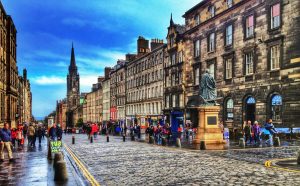 On a Saturday morning we hiked further uphill to Edinburgh Castle and were not surprised to find it mobbed with visitors.
On a Saturday morning we hiked further uphill to Edinburgh Castle and were not surprised to find it mobbed with visitors.
The castle was built on an extinct volcano, but it hasn’t erupted for 350 million years, so most of us there that day felt reasonably safe.
By the entrance to the castle grounds was a plaque that read, “NEAR THIS SPOT IN 1625 Sir William Alexander of Menstrie, Earl of Stirling, received sasine, or lawful possession of the royal province of Nova Scotia by the ancient and symbolic ceremony of delivery of earth and stone from Castlehill by a representative of the King. Here also (1625-1637) the Scottish Baronets of Nova Scotia received sasine of their distant baronies.” In essence, below our feet was a small patch of Nova Scotian land declared so that men granted free land in Nova Scotia didn’t actually have to go to the trouble of traveling there to make their claim. So there we were, over 4000 kilometres from my home province, yet still standing (or at least looking at) Nova Scotia soil. William Alexander, as it turned out, was a busy man and never did visit Nova Scotia. Inside the castle you will find more tourists than I was comfortable with but if you want to see the Stone of Destiny (the rock, not the movie) you’ll have to pay your money and take the tour.
The statue that made the most impression on me along the Royal Mile was that of Adam Smith. I had never seen a statue of an economist before and, thanks to the fact I’d been reading Arthur Herman’s How the Scots Invented the Modern World, I had learned that Smith “thought of himself primarily as a moral philosopher” and believed, unlike the church of his day, that man was primarily good rather than bad.
I hadn’t made up my own mind whether Adam Smith himself was a good guy or a bad guy. He’d said things like, “All money is a matter of belief.” And “Man is an animal that makes bargains: no other animal does this – no dog exchanges bones with another.” But Smith also said, “The real tragedy of the poor is the poverty of their aspirations.”
Alas, whatever we contemporaries felt about the man, seagulls on this fine spring day had been sitting on Mr. Smith’s metallic head and his face had been whitewashed by their plenteous droppings, reminding me vividly of the same fate of Winston Churchill’s statue in Halifax where the old public library once stood. So goes the fate of philosophers and politicians. Later, in Glasgow, pondering the famous traffic cone covering the head of Lord Wellington, I would reflect on what a hard life it is for statues in the U.K. where people and creatures can do them disservice at any time of day.
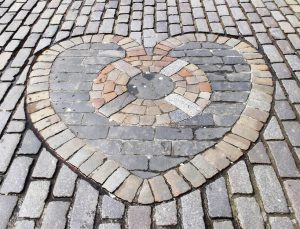 Not far from Mr. Smith, I noticed a formation of stones in the ground in the shape of a heart. This turned out to be a mosaic called the Heart of the Midlothians, where there once stood a prison built in the fifteenth century. Many executions had taken place here over the years at this very spot. There is a tradition of people spitting on the stones, perhaps initiated by the lucky ones (many of them simply men who did not pay their debts) released from jail over the centuries. Most folks I saw that day were too polite to spit and, in truth, many walked right over the spot without noticing it.
Not far from Mr. Smith, I noticed a formation of stones in the ground in the shape of a heart. This turned out to be a mosaic called the Heart of the Midlothians, where there once stood a prison built in the fifteenth century. Many executions had taken place here over the years at this very spot. There is a tradition of people spitting on the stones, perhaps initiated by the lucky ones (many of them simply men who did not pay their debts) released from jail over the centuries. Most folks I saw that day were too polite to spit and, in truth, many walked right over the spot without noticing it.
Right alongside of the Heart of the Midlothians was yet another statue – that of Walter Francis Montagu Douglas Scott, the 5th Duke of Buccleuch. Among his other accomplishments, he is given credit for importing Labrador Retrievers from Newfoundland to Europe for the first time in the 1830s. In my mind, his other political achievements fell to the wayside and it brightened my day to see yet another Canadian connection, especially one involving dogs.
Linda thought we should lunch at the Elephant House where it was reported that J.K. Rowling once did some writing or research for the early Harry Potter novels.
The sign outside says “The birthplace of Harry Potter” – but that maybe stretching it a bit. Who knows?
Inside, it was a noisy, happy little restaurant on the King George IV Bridge. The “bridge” itself confused me somewhat in that it didn’t seem to be over any body of water, but looking down from the bridge, was a whole other level of the city with narrow streets and ground level stores. I couldn’t quite figure out how this could be since we, too, were on ground level. It was like peering into another world below us and it was indeed as Harry Potteresque as a thing could be.
I still had a small grudge against Ms. Rowling because trashy newspapers in England and Scotland had claimed she had the cutest West Highland White Terrier in the U.K. I thought my own Westie much cuter and soon he too would be in the U.K. and we would try to right this wrong. Nonetheless, there we were for lunch in her former haunt with memorabilia from herself and great gobs of Harry Potter graffiti aplenty on the walls of the loos. I ordered haggis, neeps and tatties (“Our Scottish national dish”) for lunch in honour of the occasion and found it most filling.
Back on the Royal Mile we wandered down as many narrow alleyways (or closes, as they are called) as we could. Among the many are Advocate’s Close, Anchor Close, Old Post Office Close, and the curiously named Fleshmarket Close – which refers to what was once a butcher’s market rather than a place for street sex. Mystery writer Ian Rankin borrowed the name for the title of one of his novels where a number of dark and brutal events occur.
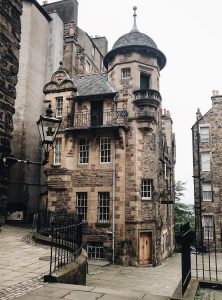 Down one alleyway, we came upon The Writer’s Museum which is blessedly free and open to the public. The building dates back to 1622 and displays artifacts and images of Robbie Burns, Sir Walter Scott and Robert Louis Stevenson. Behind a glass case, Stevenson’s high top shoes looked like he had just taken them off yesterday and I was rather impressed to see a photograph of the author of Treasure Island imbibing kava with some shirtless citizens of Samoa. I’d read Treasure Island as a lad and it had not occurred to me that perhaps drugs were involved in the creative process.
Down one alleyway, we came upon The Writer’s Museum which is blessedly free and open to the public. The building dates back to 1622 and displays artifacts and images of Robbie Burns, Sir Walter Scott and Robert Louis Stevenson. Behind a glass case, Stevenson’s high top shoes looked like he had just taken them off yesterday and I was rather impressed to see a photograph of the author of Treasure Island imbibing kava with some shirtless citizens of Samoa. I’d read Treasure Island as a lad and it had not occurred to me that perhaps drugs were involved in the creative process.
There was much ado in the museum about Burns’ poetry and it prompted me to recite what I could remember of “A Man’s a Man for a’ That” until my wife grew embarrassed enough to elbow me in the ribs to MAKE ME desist. A few steps further along, staring at a bust of Walter Scott, I couldn’t for the life of me remember reading a single thing by such a famous Scottish writer and wondered why his fame lingered while his writing fell out of favour.
Stumbling upon Devil’s Close, we ambled into a pub called The Devil’s Advocate to quench our thirst and moved on to dinner at an establishment called the Filling Station on High Street where I ordered a curry dish, having done my duty earlier in the day to partake of the Elephant House haggis.
Pubs and restaurants there are aplenty in and around the Royal Mile.
Halfway through my curry, it occurred to me that here in Scotland I was eating Indian food, in England I opted for Italian food, in the U.S. Mexican food, and in Canada, I preferred Thai.
The following morning, Wetherspoon’s near the train station provided nourishment for the day in the form of a tasty but lumpy egg, a couple of rashers of bacon, a delightfully bulbous sausage and the inevitable black pudding (it’s the blood that makes it black, yes?) I couldn’t help but notice that a large percentage of men were drinking large mugs of beer with their breakfast and, asking a waiter why that might be, he explained that Monday was a bank holiday.
As you can tell, I probably have not done the city full justice, having skipped or merely glanced at some of the more famous sites, both ancient and modern, of Edinburgh. The bagpipers were in tune on most corners, and I confess I was shocked at the cost of an authentic kilt. During the day, buskers juggled large knives while atop rolling planks, hen parties sang a Helen Reddy song in unison, and a number of young inebriated semi-clad men covered a reasonable rendition of “Wonderwall” by Oasis, then ran off, leaving one of their own behind who turned his back on the throng of curious onlookers and urinated on the wall of St. Giles Cathedral, whose crown shaped steeple dates back to the fifteenth century.
Heading back along King George IV Bridge, we stopped by Greyfriar’s Kirk which has “stood in the same spot since 1620 – the first new kirk to be built in Post-Reformation Scotland.” Here we came upon a shrine erected to a dog known as Greyfriar’s Bobby that much reminded me of the statue of the loyal dog Hachiko I had once stumbled upon in Tokyo.
Bobby was a Skye terrier (closely related to Westies, I might add) who “guarded” his owner’s grave every day for fourteen years after the man’s death back in the nineteenth century. In a nearby bookstore, I noted that there were at least twelve children’s books written about Bobby and at least two animated movies. Clearly, loyalty in dogs is admired by Scots and authors in many parts of the world.
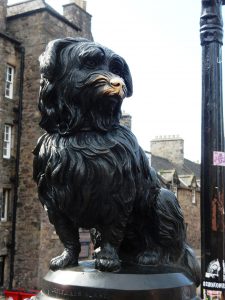 So far we had failed to find any dogs in pubs, but as luck would have it, the closest pub to Greyfriar’s Kirk had two large dogs, a black one and a white one, lounging on the floor, dutifully waiting for their masters who were drinking McEwan’s ale. The establishment was called Sandy Bell’s Pub and it purported to be famous for its folk music. A fiddler and a guitar player were tucked in a corner improvising something closer to jazz than folk, but it was a comfortable and pleasant place to ponder the story of Bobby, and to see how dogs behaved in the presence of Scotsmen drinking beer.
So far we had failed to find any dogs in pubs, but as luck would have it, the closest pub to Greyfriar’s Kirk had two large dogs, a black one and a white one, lounging on the floor, dutifully waiting for their masters who were drinking McEwan’s ale. The establishment was called Sandy Bell’s Pub and it purported to be famous for its folk music. A fiddler and a guitar player were tucked in a corner improvising something closer to jazz than folk, but it was a comfortable and pleasant place to ponder the story of Bobby, and to see how dogs behaved in the presence of Scotsmen drinking beer.
On a shelf over the bar was a bust of a man and a note on the wall indicated it was the “head of Hamish Henderson.” I wondered what a replica of this man’s head was doing in a pub and later learned Hamish was a poet, songwriter, collector of folk songs and lore, as well as a soldier and a communist – quite the list of accomplishments. I couldn’t help but take a moment of reverie to wish that someday a pub owner would think enough of me to place a replica of my head over the bar to keep a watchful eye over generations of patrons. Alas, it was a foolish and ill-conceived idea if ever there was one.
I also noted a sign over the bar that read, “No Football Colours Allowed,” and I asked a gent sipping scotch what that was all about. “Fights,” he said. “Ya can’t have two different colour shirts in one pub or you have trouble.”
Two colours presumably indicated fans of two different teams. Combine that with enthusiasm and alcohol and presumably you have fisticuffs.
Then he pointed out the window across the street to yet another pub, an Irish one called McSweeney’s. “You want to see some ruckus, you should go over there.” And sure enough, outside McSweeny’s stood two sturdy bouncers waiting for football trouble to come their way.
But I found it not in our best interest to do further investigation into football team loyalty and hostility.
I liked the way drinkers casually walked over and around the lounging canines whose weary eyes indicated they’d be much happier sleeping under the front porch. So, in the name of research, I asked the young tattoed barmaid with a nose piercing the following question: “How does having dogs in the pub change the nature of the place?” As you might guess, it came out rather sounding formal and stilted.
The young lady gave me a funny look but an honest answer, “Well,” she said, “the dogs are much nicer than the drunks.” Truth be told, I saw no drunks at Sandy’s, but then it was the middle of the day. After that, it was a final hike back to High Street where a new piper provided the official sound track for the advancing fog rolling slowly but inexorably up the cobblestone street from the North Sea below.
~ Story by Lesley Choyce




















Leave a Comment